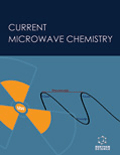
Current Microwave Chemistry
Scope & Guideline
Transforming Chemical Processes with Microwave Innovations
Introduction
Aims and Scopes
- Microwave-Assisted Synthesis:
The journal emphasizes the use of microwave technology to enhance synthetic methodologies, leading to improved yields and reduced reaction times in organic and inorganic chemistry. - Green Chemistry Principles:
A consistent focus on green synthesis methods is present, promoting environmentally friendly practices such as the use of bio-based solvents and catalysts. - Biomedical Applications:
Research exploring the application of microwave technology in the biomedical field, particularly in tissue engineering and the synthesis of bioactive compounds. - Catalysis and Reaction Optimization:
The journal covers advancements in microwave-assisted catalytic processes, including C-H activation and other bond-forming reactions, highlighting the efficiency of microwave energy in catalysis. - Multicomponent Reactions:
A significant area of focus involves multicomponent reactions facilitated by microwave heating, showcasing the versatility and efficiency of these synthetic strategies.
Trending and Emerging
- Sustainable and Eco-Friendly Approaches:
Recent publications show a significant increase in research focused on sustainability, including the use of renewable resources and green chemistry principles in microwave-assisted synthesis. - Biomedical Applications of Microwave Technology:
There is a growing trend towards utilizing microwave technology for biomedical purposes, particularly in the synthesis of materials for tissue engineering and drug delivery systems. - Nanotechnology and Microwave Synthesis:
Emerging research highlights the synthesis of nanomaterials using microwave methods, indicating a trend towards the development of novel nanostructures with unique properties for various applications. - Integration of Machine Learning in Synthesis Optimization:
An increasing number of studies are exploring the integration of machine learning techniques to optimize microwave-assisted synthesis, reflecting a trend towards data-driven methodologies in chemical research. - Advanced Catalytic Systems:
There is a notable rise in research focusing on advanced catalytic systems that utilize microwave-assisted techniques, indicating a shift towards more sophisticated and efficient catalytic processes.
Declining or Waning
- Conventional Synthesis Methods:
There is a noticeable decrease in publications focusing on conventional synthesis methods as researchers increasingly favor microwave-assisted techniques for their advantages in efficiency and sustainability. - Basic Research on Microwave Interactions:
Research centered on the fundamental interactions of microwaves with materials has become less frequent, as the focus shifts towards practical applications and advanced synthetic methodologies. - Non-Green Solvent Synthesis:
Papers discussing the use of non-green solvents in synthesis have diminished, reflecting a broader trend towards environmentally sustainable practices in chemical research. - Single-Step Reactions Without Catalysis:
There has been a decline in studies focusing solely on single-step reactions without the incorporation of catalytic processes, suggesting a move towards more complex and efficient synthetic strategies.
Similar Journals
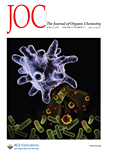
JOURNAL OF ORGANIC CHEMISTRY
Connecting Ideas and Innovations in Organic ChemistryJournal of Organic Chemistry, published by the American Chemical Society, is a prestigious peer-reviewed journal dedicated to advancing the field of organic chemistry. With an ISSN of 0022-3263 and an E-ISSN of 1520-6904, this journal has established itself as a key platform for disseminating high-quality research since its inception in 1936. Residing in the Q2 category for Organic Chemistry as of 2023, it ranks #64 out of 211 in Scopus, positioning itself within the top 69th percentile of its field. Researchers and professionals can access vital findings and innovative methodologies that drive the understanding and application of organic chemical principles. Although the journal is not open access, it remains a crucial resource in academia and industry, contributing significantly to the scientific community's knowledge base. For detailed insights and cutting-edge research, the journal continues to be an essential read for those engaged in the dynamic and evolving landscape of organic chemistry.
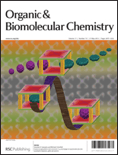
ORGANIC & BIOMOLECULAR CHEMISTRY
Driving research excellence in the heart of Cambridge.ORGANIC & BIOMOLECULAR CHEMISTRY is a prestigious academic journal published by the Royal Society of Chemistry, dedicated to advancing the fields of organic and biomolecular chemistry. With its ISSN of 1477-0520 and E-ISSN of 1477-0539, this journal plays a pivotal role in disseminating high-quality research and contributing to the scientific community, particularly in biochemistry, organic chemistry, and physical and theoretical chemistry. Currently ranked in the third quartile for Biochemistry and the second quartile for Organic Chemistry and Physical and Theoretical Chemistry, it caters to a diverse audience of researchers, professionals, and students who seek insightful studies and reviews. With a publication history spanning since 2003 and ongoing till 2024, the journal fosters open access to its articles, encouraging the free exchange of knowledge. Situated in the vibrant academic environment of Cambridge, UK, ORGANIC & BIOMOLECULAR CHEMISTRY serves as a vital resource for innovative research at the intersection of chemical sciences.

BIOORGANIC & MEDICINAL CHEMISTRY LETTERS
Pioneering research for a healthier tomorrow.BIOORGANIC & MEDICINAL CHEMISTRY LETTERS, published by PERGAMON-ELSEVIER SCIENCE LTD, is a leading journal in the fields of biochemistry, drug discovery, and medicinal chemistry, designed to disseminate significant advances in these disciplines. Established in 1991, the journal spans various important categories, including Organic Chemistry and Pharmaceutical Science, with its 2023 Scimago Journal Rank placing it at Q2 in Organic Chemistry and Q3 in several other relevant fields. Though not an open-access publication, it provides invaluable insights into contemporary research and innovative methodologies, appealing to researchers, professionals, and students alike. The journal's commitment to quality and relevance makes it a vital resource for those aiming to stay at the forefront of bioorganic and medicinal chemistry developments. For more information, please visit the journal's website as it remains a critical platform for scholarly exchange, particularly for those engaged in interdisciplinary research.

CHINESE JOURNAL OF ORGANIC CHEMISTRY
Connecting Ideas and Innovations in Organic ChemistryThe Chinese Journal of Organic Chemistry, published by Science Press, serves as a pivotal platform for advancing the field of organic chemistry since its inception in 1996. With an ISSN of 0253-2786, this esteemed journal provides robust scientific contributions, reflecting significant advancements and novel findings that are crucial to the organic chemistry community. As of 2023, it is categorized in the Q3 quartile of organic chemistry journals, positioning it within the competitive landscape of this vibrant research area, ranking #147 out of 211 in Scopus, corresponding to a 30th percentile ranking. The journal is committed to fostering a scholarly exchange of ideas and research, making it an essential resource for researchers, professionals, and students dedicated to exploring the complexities and applications of organic compounds. The Chinese Journal of Organic Chemistry continues to support the dissemination of high-quality research that contributes to both local and global scientific endeavors.
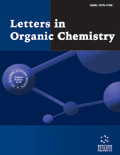
LETTERS IN ORGANIC CHEMISTRY
Connecting Minds in Organic ChemistryLETTERS IN ORGANIC CHEMISTRY is a distinguished journal published by Bentham Science Publishers Ltd, focusing on the rapidly evolving field of organic chemistry. Established in 2005, the journal commits itself to disseminating vital research findings, reviews, and innovative methodologies that contribute to the understanding and advancement of organic chemistry and biochemistry. With an ISSN of 1570-1786 and an E-ISSN of 1875-6255, this journal enhances accessibility and visibility for authors and readers alike, albeit not adopting an open-access model. Positioned within Q4 quartile rankings for both Biochemistry and Organic Chemistry, it serves a niche audience keen on exploring emerging trends and breakthroughs in these disciplines. Its Scopus rankings further reflect its role in the global academic landscape, albeit at the beginning stages of its impact journey. Based in the United Arab Emirates, LETTERS IN ORGANIC CHEMISTRY is dedicated to fostering dialogue among researchers and practitioners, paving the way for future innovations in organic and biochemical sciences.
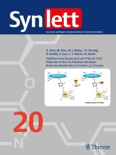
SYNLETT
Unveiling Breakthroughs in Organic Compound ResearchSYNLETT is a prominent academic journal dedicated to the field of Organic Chemistry, published by GEORG THIEME VERLAG KG. Since its inception in 1989, the journal has played a critical role in advancing the understanding of synthetic methodologies and organic compounds, offering a platform for innovative research and discoveries. With an ISSN of 0936-5214 and an E-ISSN of 1437-2096, SYNLETT is well-regarded in the academic community, presently positioned in the Q3 quartile for Organic Chemistry according to the 2023 category rankings. The journal is particularly valuable for researchers and professionals seeking insights into contemporary organic synthesis methods and their applications. Although it does not operate under an Open Access model, it remains a crucial resource within the field, contributing to significant advancements and collaborations globally. For those engaged in organic synthesis, SYNLETT not only encapsulates cutting-edge research but also inspires innovation in the discipline.

Heterocyclic Letters
Unveiling Innovations in Heterocyclic ResearchHeterocyclic Letters is an esteemed journal in the field of synthetic organic chemistry, published by RAMAN PUBL. With ISSN 2231-3087 and E-ISSN 2230-9632, this journal aims to disseminate original research and innovative findings related to heterocyclic compounds, which play a crucial role in medicinal chemistry, material science, and agricultural chemistry. Heterocyclic Letters provides a platform for researchers, professionals, and students to share their insights and advancements, thus fostering academic collaboration and knowledge transfer. The journal is dedicated to maintaining high-quality standards in research publication, making it an essential resource for anyone focused on the latest developments in heterocyclic chemistry. Although it does not currently offer Open Access options, the journal’s rigorous peer-review process ensures that only the most credible and impactful studies are published, contributing significantly to the advancement of the field.

ADVANCED SYNTHESIS & CATALYSIS
Catalyzing the future of synthetic chemistry.ADVANCED SYNTHESIS & CATALYSIS is a prestigious academic journal published by Wiley-VCH Verlag GmbH, based in Germany. This journal, with ISSN 1615-4150 and E-ISSN 1615-4169, plays a pivotal role in the fields of Chemistry and Chemical Engineering, earning commendable rankings such as Q2 in Catalysis and Q1 in Organic Chemistry in 2023. Its high impact factor and recognition—ranking #18 in both Organic Chemistry and Catalysis—further underscore its significance as a platform for groundbreaking research and innovative methodologies. Spanning from 1996 through 2024, ADVANCED SYNTHESIS & CATALYSIS aims to disseminate high-quality, cutting-edge studies related to synthetic processes and catalytic technologies, ensuring accessibility via their open access options. By fostering a vibrant scholarly community, this journal serves as an essential resource for researchers, professionals, and students dedicated to driving advancements in synthetic and catalytic chemistry.
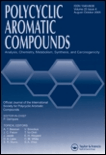
POLYCYCLIC AROMATIC COMPOUNDS
Exploring the Depths of Chemical ComplexityPOLYCYCLIC AROMATIC COMPOUNDS, published by TAYLOR & FRANCIS LTD, is a pivotal journal dedicated to the study of polycyclic aromatic compounds, which play a significant role in fields spanning materials chemistry, organic chemistry, and polymers. With an ISSN of 1040-6638 and an E-ISSN of 1563-5333, this journal features a robust collection of research that informs and guides advancements in understanding the complex interactions and applications of these compounds. Having established its presence since 1990, POLYCYCLIC AROMATIC COMPOUNDS currently holds a Q3 ranking in multiple categories, including Materials Chemistry, Polymers and Plastics, and Organic Chemistry, showcasing its consistent contributions to scientific dialogues. Though traditionally not an open access journal, it provides immense value to researchers, professionals, and students seeking reliable and impactful studies. The journal is located in the United Kingdom at 2-4 PARK SQUARE, MILTON PARK, ABINGDON OR14 4RN, OXON, ENGLAND, and continues to be a trusted source for cutting-edge research in the field.

JOURNAL OF HETEROCYCLIC CHEMISTRY
Advancing Knowledge in Organic ChemistryJournal of Heterocyclic Chemistry, published by Wiley, stands as a key resource in the field of organic chemistry, offering in-depth research articles and insights spanning from 1966 to 2024. With its strong Scopus ranking of #83 out of 211 in the Organic Chemistry category, placing it in the 60th percentile, the journal maintains its significance and relevance within the academic community. Although it does not currently offer open access options, it provides extensive coverage of heterocyclic compounds, which are vital to various applications in pharmaceuticals and material sciences. The journal's commitment to high-quality research is further reflected in its classification as Q3 in the 2023 quartiles for Organic Chemistry. Researchers, professionals, and students alike will find valuable contributions to the intricate studies of heterocycles, enhancing their understanding and exploration of this fascinating area of chemistry.